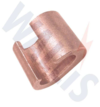Not something I'm intending on doing, but thought I'd raise the topic for fun and maybe learn a bit more.
I gather using metal trunking to provide the earth/cpc for a circuit is acceptable, in the same way metal conduit can be used.
Usually we don't see metal trunking used as a cpc, as it's generally easy enough to bung a green and yellow wire in the trunking.
But has anyone used the trunking where a phase or three phase wires, and a neutral wire perhaps were already in place, and running an earth wire was too much trouble due to it being a massive long run?
And would you do this if the trunking has many circuits (with separate cpcs), and again, you don't fancy running a new cpc?
I gather using metal trunking to provide the earth/cpc for a circuit is acceptable, in the same way metal conduit can be used.
Usually we don't see metal trunking used as a cpc, as it's generally easy enough to bung a green and yellow wire in the trunking.
But has anyone used the trunking where a phase or three phase wires, and a neutral wire perhaps were already in place, and running an earth wire was too much trouble due to it being a massive long run?
And would you do this if the trunking has many circuits (with separate cpcs), and again, you don't fancy running a new cpc?


